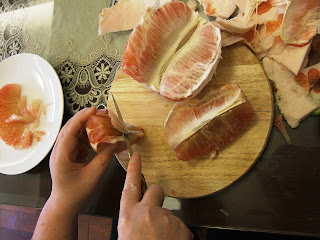Vietnam is full of great fruit. I haven't even tried all the fruits there are at my local market yet. But a firm favourite in our little family has turned out to be the pomelo.
Pomelo are really common here and I think available all year round - though I'll let you know if the supply suddenly stops later in the year. Pomelo are big. About the size of a volleyball. It's a citrus fruit and it often gets compared to grapefruit in terms of flavour and structure. But actually, the flavour is a lot sweeter than grapefruit, and more delicate too. It's a very fragrant fruit, but it doesn't overwhelm you with it's flavour the way some citrus fruits do - it's not overly acidic. I guess that's why it's commonly used in salads - it provides texture and softness and fragrance, but it's not overpowering. It's happy to share the plate with a bit of chilli and fishsauce and coriander and mint and won't throw a tantrum about it.
We like to eat it just on its own - straight out of its skin.
Pomelo can seem a bit daunting if you've never tried to get into one before. And the tutorials I've seen online are all about peeling a pomelo the traditional way, being careful not to waste any of the precious flesh and spending hours and hours and hours picking at the rind until the wedges are stripped yet intact.
I reckon that a pomelo is big enough that a tiny bit of wastage is ok if it means you can peel it in under 10 minutes. The rind of the pomelo is really thick. Like, inches of thick, fibrous, white pulp. And of course, a pomelo is round, so the first thing you need to do is cut off the top and bottom of the rind to give yourself a flat working surface. Your first cut should be a couple of inches away from the edge.
 |
| It's never a good idea to knife something that wobbles. |
Keep taking thin slices off, until you've exposed most of the segments of the fruit inside. The flesh of this one is pink. The pink fleshed ones are a lot more expensive that the yellow-fleshed ones, and apart from the colour there are some other subtle differences too. The rind is thicker, and more fibrous, which makes it harder to slice into initially, but easier to peel at the end. The fruit itself is a bit sweeter and has more flavour, and the little sections inside the fruit are bigger and juicier - they pop between your teeth. However, I think that the biggest factor leading to the price difference is the colour - red is a lucky colour here, and during Tet, pink pomelos were for sale everywhere as a auspicious treat. People buy them as gifts for family.
This pomelo was especially lovely and expensive at about $4. Note the unmarked, bright green skin and stem still intact. Cheaper, yellow pomelo I usually buy for less than $1.
The fruit of the pomelo is attached to the skin by a fibre that runs all along the pointy part of each wedge, and down the centre of the back of the wedge. So the aim in peeling is to slice off that back fibre down each wedge along with the thick white rind. You can see the yellow-ish green-ish spots behind each wedge of fruit in this picture - those spots are the fibres.
 |
| Slide your knife between the fibre spot and the fruit flesh |
Now cut in a downward curve. Don't worry about the little bit of flesh you've carved off - there'll still be plenty left. Repeat for each segment until you've exposed the whole topside of the fruit.
Then flip it, and repeat for the other side. You should be left with a beautiful stripy ball.
Now, stick your thumbs in the hole, and pull the flesh apart.
 |
| This makes a pleasing ripping sound. |
If you can, tear it into quarters. If it's not very weildy, you can slice it - just aim your knife at one of the fibrous segments rather than into the flesh. Then, trim down the point of the wedge and remove the fibrous binding. This should be the last bit of cutting you will need to do.
 |
| Your knife needs to be quite sharp for this bit. |
This is the funnest part - you just need to peel off the papers with your fingers, and plop the wedges out onto a plate.
They can be quite delicate so don't worry if they break - they still taste good!
 |
| Mrs Martin and The Tramp |





We too are fans of the Pomelo, first tried them on a boat trip in Thailand. Good article Mrs Martin. Love the photo of you and The Tramp!
ReplyDeleteHello Mrs Martin..I have finally figured out how to reply to your post (Thanks anonymous). Good to see you both on Sunday. The cat was happy to see you also. Chch has had another large earthquake 6.3 and people died. Will keep reading with relish.... Sprout.
ReplyDelete